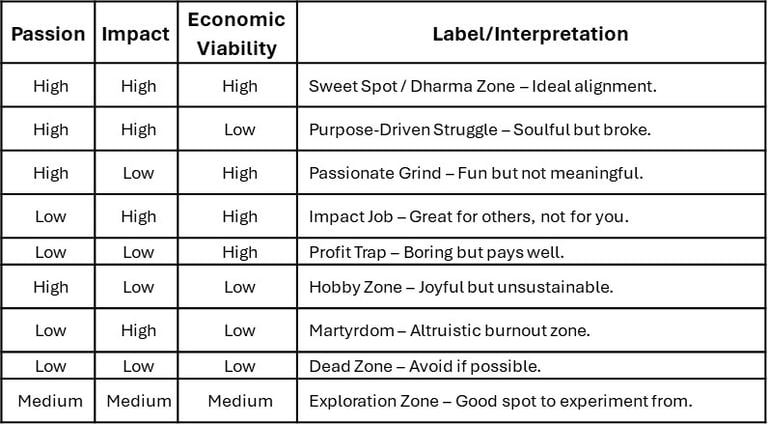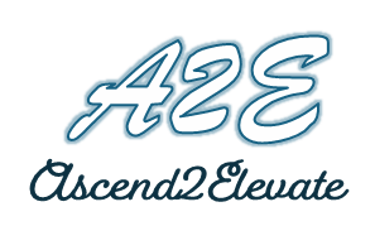PIE Framework - Career Choices Decoded
CAREER DEVELOPMENT
Tarun Mehta
5/30/20254 min read


PIE Framework - Career Choices Decoded, a 3-dimensional Guide to Doing What You Love and Making It Work
In a world full of career choices, side hustles, social causes, and business ideas, how do you decide what is truly worth pursuing? Should you follow your passion, chase the money, or make an impact in the world?
The answer is not always either/or. Instead, imagine a 3D space, a cube, where your Passion, Impact, and Economic Viability (P, I and E) intersect. Think of it like plotting your ideas or career options on a graph with three axes:
X-Axis: Passion – How much you love doing it.
Y-Axis: Impact – How much it benefits others or the planet.
Z-Axis: Economic Viability – Whether it pays the bills or scales financially.
By rating each idea or path as high, medium, or low on these axes, you can find your “zone”, the area your project or career currently lives in. There are nine possible zones, and each one carries different rewards and trade-offs.
Let us explore them one by one with examples.
1. Sweet Spot / Dharma Zone (High Passion, High Impact, High Viability)
This is the ultimate alignment. You love the work, it changes lives, and it sustains you financially. It is your ikigai, your dharma, or simply your dream job.
Example: Think of someone like a social entrepreneur who creates an eco-friendly product line that people love, generates solid profits, and reduces plastic waste globally. They wake up excited, feel fulfilled, and are not stressed about money. Win-win-win.
This is the zone to aim for, but it usually takes time, experimentation, and courage to get here.
2. Purpose-Driven Struggle (High Passion, High Impact, Low Viability)
Here, you are doing what you love, and it helps others, but the money just is not flowing. It can be deeply rewarding but financially stressful.
Example: A passionate educator who runs free community classes on mental health awareness. The sessions are full, and people’s lives are changing but she is funding it from her own savings. Eventually, this can lead to burnout unless supported by grants, donations, or a parallel income stream.
This zone is soulful but needs a bridge to sustainability.
3. Passionate Grind (High Passion, Low Impact, High Viability)
You love what you do, and it pays well, but it does not really make a difference beyond you. It can feel fun but sometimes empty.
Example: A YouTuber who reviews luxury gadgets. They are making good money and genuinely enjoy the work, but after a few years, they start wondering, “Am I adding value, or just selling stuff?”
This zone is great for personal joy and income but may lack deeper purpose unless consciously infused with meaning.
4. Impact Job (Low Passion, High Impact, High Viability)
You are helping people and making a decent living, but your heart’s not in it. Over time, it can feel like duty, not delight.
Example: A nonprofit fundraiser who is amazing at bringing in donations for a cause they believe in, but secretly dreads writing grant proposals and organizing galas. They are good at it, and it matters but they are not energized.
This is a noble path, but without passion, it risks quiet dissatisfaction or quiet quitting.
5. Profit Trap (Low Passion, Low Impact, High Viability)
It pays well, but it feels like soul erosion. You are just clocking in and out, with little sense of joy or contribution.
Example: A mid-level manager in a tobacco company who earns a big paycheck but hates the work and does not believe in the product. There is no excitement, and morally, it feels off.
This is a common place people get stuck in. Escaping the trap means prioritizing fulfillment over comfort.
6. Hobby Zone (High Passion, Low Impact, Low Viability)
This is joyful but not sustainable. It is more play than profession.
Example: A weekend musician who loves jamming and creating songs in their bedroom but rarely shares their music or makes money from it. It is pure bliss, but it will not pay rent.
This zone is perfect for creative outlets but turning it into a livelihood requires strategy and scaling.
7. Martyrdom (Low Passion, High Impact, Low Viability)
You are doing good for the world, but at the cost of your own well-being—financially and emotionally.
Example: A climate activist who tirelessly organizes rallies and educates others, but neglects their own rest, income, and health. They are burning out faster than the planet is heating up.
This zone needs urgent attention. You cannot pour from an empty cup.
8. Dead Zone (Low Passion, Low Impact, Low Viability)
This is the danger zone where there is no joy, no meaning, no money. If you are here, it is time to pivot.
Example: A call center job that drains your energy, does not help anyone in a meaningful way, and barely covers your expenses. Every day feels like survival.
Escaping this zone is urgent. Even small steps like a side hustle or online course can open new doors.
9. Exploration Zone (Medium All Around – The Cube's Center)
Let us not forget the middle. Sometimes, your current role may be “average” on all three fronts, not bad, but not exciting either.
Example: A software developer working on backend systems in a medium-sized company. Decent salary, okay team, not exactly thrilling, not terrible. They are not in pain, but they are not in flow.
This is a good place to experiment from. From here, you can test new directions, without burning it all down.
How to Use This Framework
Whether you are a student, a mid-career professional, an entrepreneur, or simply soul-searching, here is how to apply this cube:
Self-Check: Take your current job or a new idea. Rank it High, Medium, or Low on Passion, Impact, and Viability.
Map It: Place it into one of the nine zones.
Decide the Next Move:
If it is in the Sweet Spot, protect and grow it.
If it is in Purpose-Driven Struggle, seek support or monetization models.
If you are in the Profit Trap or Dead Zone, start looking for lifeboats.
If you are in the Hobby or Martyr zone, add strategy or self-care.
Revisit Often
Life is not static. Roles evolve. What was once just a “hobby” could become your career. What felt impactful may lose meaning. Use this tool not once but regularly especially during transitions.
Final Thoughts
Success is not just about passion, impact, or profit in isolation. It is about finding the intersection - the place where your joy, service, and sustainability meet. Not every journey begins in the Sweet Spot, but with awareness and courage, it can move toward it. So, where are you in the cube right now? Let us understand and get into the right spot.
Video available at: https://youtu.be/oWIyVPUUyxU



